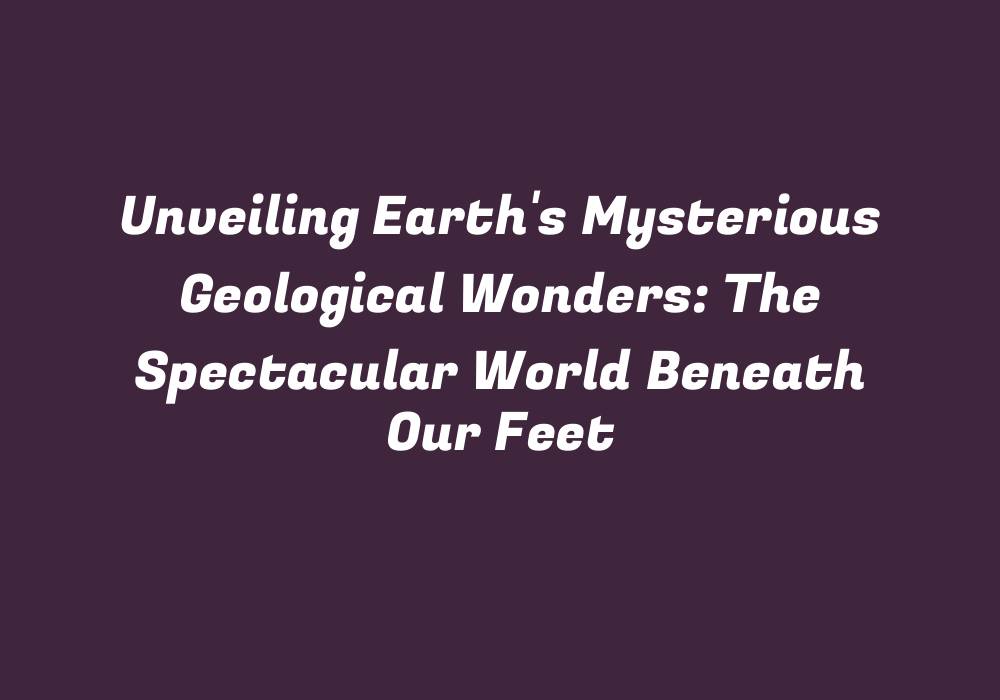Introduction
Our planet, Earth, has been a source of wonder and mystery throughout history, especially for its hidden treasures beneath our feet. This article aims to unravel some of these mysterious geological wonders that have captured the imagination of scientists, scholars, and nature enthusiasts alike. We will explore their formation and significance in shaping the world around us.
Hydrosphere: The Hidden Depths of Our Oceans
Oceanic Trenches
Submerged deep beneath the ocean surface are vast canyons known as oceanic trenches. These immense crevasses extend from 5 to over 10 kilometers in depth, with some being the deepest points on Earth. The Mariana Trench, found at the bottom of the Pacific Ocean, reaches a staggering 10,984 meters (approximately 36,034 feet) and is known as the deepest point ever recorded. These trenches are believed to have formed during continental collisions, with large segments of Earth’s crust being dragged downward into the mantle and eventually creating these chasms.
Mid-Ocean Ridges
Stretching along the ocean floors for thousands of miles are mid-ocean ridges. These underwater mountain ranges form at the boundary between tectonic plates, with new crust being created as magma from Earth’s mantle rises up through the fractures and solidifies. This process continues at a rate of approximately 25 meters per year along these ridges, contributing to the ongoing creation of our planet’s surface. Some notable examples include the Mid-Atlantic Ridge and the East Pacific Rise.
Seafloor Spreading
One of the most fascinating geological processes occurring beneath our oceans is seafloor spreading. It is characterized by the gradual movement of tectonic plates in opposite directions, causing new oceanic crust to be formed at mid-ocean ridges while the older crust sinks into the mantle at subduction zones. This process creates a continuous cycle and plays a significant role in shaping the Earth’s surface features over time.
Lithosphere: The Unseen Power of Continents and Plates
Continental Drift
The movement of tectonic plates, which underlies continental drift theory, has been a subject of debate for centuries. This idea was first proposed by Alfred Wegener in the early 1900s to explain the apparent fit of various landmasses on different continents and their seemingly similar geological features across vast distances. Through modern scientific advancements and extensive research, we now know that these plates are moving at varying speeds and contribute to numerous geological phenomena, including earthquakes, volcanic eruptions, and mountain formation.
Subduction Zones
As mentioned earlier, subduction zones occur where tectonic plates descend into the mantle beneath another plate. This process often results in powerful undersea earthquakes and volcanic activity on land, creating some of Earth’s most active landscapes. For instance, the Aleutian Arc in Alaska is a chain of volcanoes situated along an island arc above the Pacific-North American plate boundary due to subduction of the Pacific Plate beneath the North American Plate.
Continental Shields and Cratons
The oldest, most stable parts of Earth’s continental crust are called cratons or shields. They have been relatively unaffected by tectonic activity and erosion over the past billion years, making them significant repositories of geological history and knowledge about our planet’s evolution. For instance, the Baltic Shield in Scandinavia contains some of Earth’s oldest rocks and is composed mostly of ancient gneisses and granites.
Atmosphere: The Intriguing Interactions of Wind, Weather, and Climate
Atmospheric Circulation
The movement of air in the Earth’s atmosphere, particularly the interactions between air masses, is crucial for weather patterns and climate variations. This circulation is driven by differences in temperature and pressure, leading to global wind systems like the Hadley, Ferrel, and Polar cells that influence weather and climate across various regions. For example, the trade winds from the northeast to the southeast in the tropics help maintain a stable climate for many island nations in the Pacific Ocean.
Weather Phenomena
Throughout Earth’s history, various weather events have shaped landscapes and influenced human life. From hurricanes and tornadoes to monsoons and blizzards, these phenomena can cause immense damage and loss of life. They are driven by complex interactions between the atmosphere and other geological forces, such as ocean currents and topography, resulting in a diverse range of weather patterns that continue to fascinate scientists and the general public alike.
Conclusion
The wonders beneath our feet have long been a source of intrigue for both scientists and casual observers, captivating imaginations with their mysterious forms and the sheer scale of their existence. From the depths of Earth’s oceans to the expansive continental landscapes, these geological marvels are constantly evolving and shaping our planet in ways that remain awe-inspiring even after centuries of scientific advancements. By unraveling the mysteries hidden beneath our feet, we gain a deeper understanding of Earth’s past, present, and future as well as our own place within its vast and intricate ecosystem.
